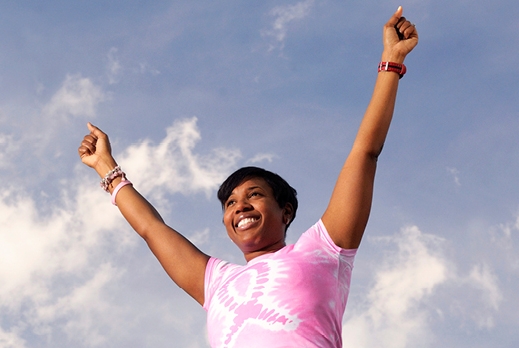Jan. 2, 2009. That's when the journey began for Shawn Ware, her husband Albert, daughter Demitria, son Jalen, and mother Eva Freeman.
A little lump she felt while in the shower took the family on the odyssey that is breast cancer. Ware had a lumpectomy and treatment with radiation therapy and chemotherapy.
"You know those side effects that you see in fine print? I had all those and more," she says, somehow able to laugh about them now. "I didn't know that your eyelashes act as windshield wipers, and when I lost mine, I had to wear glasses just to keep things from getting in my eyes."
Ware triumphed. "I was ready to conquer the world after my last round of radiation," she says. And three years later, she is considered a survivor and a reason for celebration.
"Cancer, it stinks," says Ware, the general manager of Blomeyer Health Fitness Center at Emory. "But you do change. You certainly learn to appreciate the good and not let the little things bother you any more."
Like millions of other Americans, Ware is part of a growing trend — more people than ever are surviving cancer. In just six years, the number of cancer survivors has jumped by almost 20 percent, according to the Centers for Disease Control and Prevention and the National Cancer Institute — 11.7 million in 2007, up from 9.8 million in 2001, the most recent years available.
The good news comes with some challenges, however. As cancer treatment has become more successful, survivors — and their caregivers and providers — have learned that there is a cost to surviving.
"Long-term survivorship starts on the day treatment ends," says nurse practitioner Joan Giblin, the director of Winship's new Survivorship Program. "You're actively doing something during treatment, but when treatment ends, many patients tell us they feel like they have been set adrift without a clear course. Our survivorship program is trying to bridge that gap and provide survivors with tools for these difficult times."
Giblin says that some survivors respond by isolating themselves. Still others "jump right back into their old lives or try to adjust to a new life by adapting to any after-affects they may still be experiencing."
Survivors of all types of cancer can face myriad physical issues. Treatment itself can be so hard on the body that survivors sometimes suffer chronic pain, heart problems, depression, sexual dysfunction, and a mental fogginess dubbed "chemo brain." They also are at heightened risk for recurrence and secondary cancers.
Physical problems arise within individual cancer groups. For example, head and neck cancer patients often have trouble swallowing and lose their sense of taste. Breast cancer patients must deal with the changes that come as a result of a lumpectomy or mastectomy and reconstruction.
In addition, family and relationship problems may arise as all in a survivor's relationship network struggle to adjust to cancer and life after cancer. Emotional challenges abound, from sadness, fear, and anger to serious depression. Fatigue is common.

